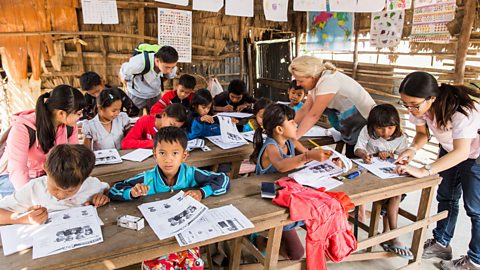Definitions of population change
Population balance is the balance achieved between the number of births and deaths within a population.
Crude Birth Rate (CBR): the number of live births each year per thousand of the population in an area.
Crude Death Rate (CDR): the number of deaths each year per thousand of the population in an area.
Natural change is achieved when there is an imbalance between the CBR and the CDR.
A natural increase is achieved when there is a higher birth rate than death rate.
A natural decrease is achieved when there is a higher death rate than the birth rate.
Patterns of population growth
Rates of population growth vary across the world.
Although the world's total population is rising rapidly, not all countries are experiencing this growth.
In the UK, for example, population growth is slowing, while in Germany the population has started to decline.
More Economically Developed Countries MEDCMore Economically Developed Country ÔÇô usually a rich country found in Western Europe or North America. have low population growth rates, with low death rates and low birth rates.
Less Economically Developed Countries LEDCLess Economically Developed Country ÔÇô usually a poorer country found in South America, Africa or Asia. have high population growth rates.
Both birth rates and death rates in LEDCs tend to be high.
However, improving healthcare leads to death rates falling - while birth rates remain high.
The table shows data in selected LEDC and MEDC countries. The figures are per 1,000 of the population per year.
MEDCs
| Country | Birth rate | Death rate | Natural increase | Population growth rate (%) |
|---|---|---|---|---|
| UK | 11 | 9 | 2 | 0.2 |
| Canada | 10 | 8 | 2 | 0.2 |
| Bulgaria | 9 | 16 | -7 | -0.7 |
LEDCs
| Country | Birth rate | Death rate | Natural increase | Population growth rate (%) |
|---|---|---|---|---|
| South Africa | 20 | 9 | 11 | 1.1 |
| Botswana | 24 | 6 | 18 | 1.8 |
| Zimbabwe | 29 | 8 | 21 | 2.1 |
Demographic transition model
The demographic transition modelThis is a model which shows how population has changed over time. It shows how birth rate and death rate have influenced the total population of a place and changed over the years. shows population changeThe population of an area is never static. It is dynamic and is always changing ÔÇô a population can change naturally due to births and deaths or artificially by migration. over time.
It studies how birth rate and death rate affect the total population of a country. It shows marked differences between LEDCs and MEDCs.
Five stages of the demographic transition model
As a country passes through the demographic transition model, the total population rises.
Most LEDCLess Economically Developed Country ÔÇô usually a poorer country found in South America, Africa or Asia. are at stage 2 or 3 (with a growing population and a high natural increase).
Most MEDCMore Economically Developed Country ÔÇô usually a rich country found in Western Europe or North America. are now at stage 4 of the model and some such as Germany have entered stage 5.
All countryÔÇÖs populations move through the stages of the model. Some move more quickly than others, so different countries are at different stages.
The gap between the birth and death rates on the model shows natural change. Where the birth rate is higher than the death rate, this is a natural increase.
Natural increase is at its highest between Stages 2 and 3. In stage 5, when the death rate is higher than the birth rate, this is a natural decrease.
Each stage has its own characteristics to help identify it.
Stage 1: Birth and death rates are both high. Total population is low but it is balancedA population is in balance when birth rates equal death rates. due to high birth rates (36/37 per 1,000) and high death rates (36/37 per 1,000). Countries at this stage will usually be undeveloped. However, there are no longer any countries at this stage of the model.
Stage 2: This is when the death rate falls rapidly. The birth rate remains high. Total population will start to rise because the death rates will start to fall (to around 18/19 per 1,000).
Birth rates will remain high due to:
- Due to previous high rates of infant mortality, parents keep having babies in the hope some will survive.
- Children being used as economic assets. They work on family farms and help to produce food for survival.
- Tradition and culture. Religious beliefs will dictate that families must be large.
- No availability of contraception.
Death rates fall due to:
medical care will be improved (vaccinations, scientific improvements, doctors and new drugs);
sanitation and water supplies will be much better;
the quality and security of food will be improved;
there will be a noticeable decrease in child mortality.
Stage 3: This is when the birth rate begins to fall rapidly. The death rate continues to fall but much more slowly. Total population is rising rapidly. The gap between birth and death rates will narrow. natural increaseA rise in the number of people due to a higher birth rate than death rate. is slowing down but still high. Death rates will fall but slow and steady (to 15 per 1,000) but birth rates will fall quickly (down to around 18 per 1,000).
Birth rates fall due to:
increased use of family planning methods;
much lower infant mortality rates will mean that more children will survive and there is less need to have as many babies;
increased opportunity for employment in factories means that fewer people (and children) are required to work on the land;
laws that say children must attend school, so they are no longer earning for the family;
changes to society put more desire on material possessions than large families;
changes to equality mean that women are increasingly in the workforce and not ÔÇÿstaying at homeÔÇÖ to look after the children.
Stage 4: This is when the birth and death rates are both low and usually balanced. Total population is high and growing slowly. It is balanced by a low birth rate (15 per 1,000) and a low death rate (12 per 1,000). Contraception is widely available and there is a social desire to have smaller families.
Stage 5: At this stage both rates remain relatively low, but the death rate is now higher than the birth rate. Total population is still high but starting to decline due to the birth rate falling (to 7 per 1,000) below the death rate (9 per 1,000). The population will start to fall as it is no longer replacing itself and may go into decline. The population is ageing and will gradually be dominated by older people.
The five stages of the demographic transition model.
The five stages of the demographic transition model.
More on Population and migration
Find out more by working through a topic
- count2 of 3

- count3 of 3
